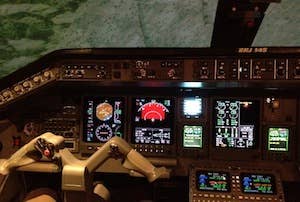
This week, I had an opportunity to learn more about upset recovery training at APS Emergency Maneuvers Training at the Phoenix-Mesa Gateway Airport in the southeastern edge of Mesa, Arizona. With temperatures above 100 degrees Fahrenheit outside, it was nice to step into the air-conditioned CAE full motion Level D ERJ 145 simulator at the Arizona State University campus across the street from the APS facility.
This type of training is valuable since it shows what can happen when an airplane goes beyond its design limits, while being in the safe environment of the sim. Not only is the stress of the unusual attitudes removed, the simulator can also be stopped at any time so that the instructor can explain in detail what is going on and how to properly correct the upset state with the least stress to the airplane.
APS’ president Paul “BJ” Ransbury strapped me into the left seat of the simulator and we worked through several eye-opening scenarios. Ransbury had me fly the ERJ 145 through some steep turns and stalls to get me used to how the airplane flies and emphasize the jet’s approach to stall indications, with the speed tape coming up, pitch limit indicator coming down and eventually the stick shaker coming on. We also maneuvered the airplane, first to a stall way beyond the airplane’s stall speed by banking and pulling back on the elevator, then keeping the airplane under control below its stall speed by unloading the elevator, emphasizing that it is angle of attack, not airspeed, that is responsible for the stall. While I knew this in theory, it was quite interesting to see it in extreme reality, which I had also had a chance to do earlier in the Extra 300 APS uses as its main training aid.
After I felt comfortable maneuvering in the simulator, Ransbury had me do full deflection turns up to 60 degrees of bank. Ransbury explained that one obstacle that pilots who fly larger jets need to overcome is the ability to get aggressive with the airplane. Pilots flying passengers are generally focused on flying as smoothly as possible to keep the people in the back happy. But at a sudden and unexpected steep bank, it is important to manhandle the airplane quickly to get it back to a stable attitude.
After attempting a few full deflection bank turns to 60 degrees and realizing the attitude was not very difficult to fix by applying opposite control inputs and allowing the airplane to stabilize, Ransbury had me move on to the rudder. It was an entirely different scenario, which was quite disturbing. Applying full rudder in one direction and then the other, an overreaction that, according to Ransbury, is the response of many pilots when the airplane reaches an upset state, made the airplane toss around violently. It only took a couple of rounds of applying rudder in each direction before the airplane was completely out of control.
The response was quite disturbing and after Ransbury stopped the simulator he explained that, had we continued to apply rudder as we were, the vertical stabilizer may have departed the airplane. This is likely what happened to American 587, the Airbus A300 that crashed on November 21, 2001 in Belle Harbour, New York, shortly after departing from John F. Kennedy International Airport. All 260 people on board and five people on the ground died as a result of the accident. The NTSB concluded that the probable cause of the accident was "the in-flight separation of the vertical stabilizer as a result of the loads beyond ultimate design that were created by the first officer's unnecessary and excessive rudder pedal inputs." It's worth noting that the pilot wasn't going against anything he had been trained to do and American Airlines changed its training approach as a result of the accident. Read more about American 587 in Peter Garrison's column.
When Ransbury unfroze the simulator, we left the rudder pedals alone and the oscillations gradually faded. “As a commercial pilot you want to make sure that you avoid using rudder unless there is no other alternative,” said Ransbury. “The bigger the moment the more powerful the tail and the more crazy it gets.”
To conclude the exercise, we did the most fun maneuvers of the day – aileron rolls. While the full motion simulator certainly added to the reality of the flight, it did not leave us upside down in the roll. Ransbury demonstrated a nice roll and allowed me to do one as well, making sure that I had some forward pressure on the controls throughout the roll. Then for the lesson. As we rolled around, Ransbury commanded backpressure on the yoke, another response that is the basic instinct of those who are not trained otherwise. The roll slowed and we were pointing straight at the ground. Once again, Ransbury froze the sim and talked about how to best avoid or correct this type of scenario.
With the level of realism afforded by the Level D sim, the training was very valuable. And the method APS teaches for upset recoveries, which I won’t get into here, can be applied to any airplane. “You can see that there is barely any resemblance at all between the Extra 300 and this airplane, but there is a tremendous amount of transferrable skills if it’s presented properly,” said Ransbury. Before visiting APS, I thought upset training was mostly useful for aerobatic pilots. But after seeing how it can even be applied to large jets, I realized that all pilots can benefit from this type of training.

Sign-up for newsletters & special offers!
Get the latest FLYING stories & special offers delivered directly to your inbox






